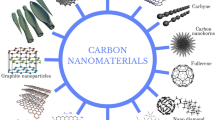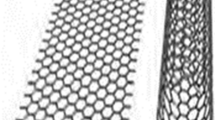Abstract
Carbon nanomaterials were synthesized by using the solution plasma process and the carbon structure was precisely controlled through adjusting electrode gap distances. Transmission electron microscope and diffraction images showed ordered graphitic layers and clear ring patterns when the electrode distance was wider. The measurement of conductive properties has been improved approximately 400 times from 19 k Ω cm to 47 Ω cm, and the C/H ratio from the result of elemental analysis decreased from 0.31 to 0.18 with decreasing resistivity of carbon. These results showed that the electrode distance was an important factor to control the energy input during the synthesis of carbon materials in the plasma/gas zone generated by solution plasma processing and strongly affect the properties of synthesized carbon materials.






Similar content being viewed by others
References
M.D. Stoller, S.J. Park, Y.W. Zhu, J.H. An, and R.S. Ruoff, Nano Lett. 8, 3498–3502 (2008).
C. Lee, X. Wei, J.W. Kysar, and J. Hone, Science 321, 385–388 (2008).
Z. Xu, Y. Zhang, P. Li, and C. Gao, ACS Nano 6, 7103–7113 (2012).
P.M. Ajayan, Chem. Rev. 99, 1787 (1999).
A. Vaseashta and D. Dimova-Malinovska, Sci. Tech. Adv. Mater. 6, 312–318 (2005).
N. Sinha and J.T.W. Yeow, IEEE Trans. Nanobiosci. 5, 180–195 (2005).
D.S. Su and R. Scholgl, Chem. Sus. Chem. 3, 136–168 (2010).
J. Liu, K. Chen, C. Davis, S. Sherlock, Q. Cao, X. Chen, and H. Dai, Cancer Res. 68, 6652–6660 (2008).
R.J. Chen, S. Bangsaruntip, K.A. Drouvalakis, N.W.S. Kam, M. Shim, Y. Li, W. Kim, P.Z. Utz, and H. Dai, Appl. Phys. Sci. 100, 4984–4989 (2002).
N.W.S. Kam and H. Dai, J. Am. Chem. Soc. 127, 6021–6026 (2005).
H. Yang, S. Amiruddin, H.J. Bang, Y.-K. Sun, and J. Prakash, J. Ind. Eng. Chem. (Seoul, Republic of Korea) 12, 12–38 (2006).
B. Scrosati, Chem. Rec. 5, 286–297 (2005).
M. Broussely, P. Biensan, F. Bonhomme, P. Blanchard, S. Herreyre, K. Nechev, and R.J. Staniewicz, J. Power Sources 146, 90–96 (2005).
M. Broussely, G.-A. Nazri, and G. Pistoia, eds., Lithium Batteries (Norwell, MA: Kluwer Academic Publishers, 2004), pp. 645–685.
C. Fellner and J. Newman, J. Power Sources 85, 229–236 (2000).
Y. Nishi, K. Katayama, J. Shigetomi, and H. Horie, 13th Annual Battery Conference on Applications and Advances, pp. 31–36 (1998).
D. Bechtold, T. Brohm, M. Maul, and E. Meissner, 38th Proceedings of Power Sources Conference, pp. 508–511 (1998).
U. Koehler, F.J. Kruger, J. Kuempers, M. Maul, E. Niggemann, and H.H. Schoenfelder, 32nd Proceedings of Intersociety Energy Conversion Engineering Conference, pp. 93–98 (1997).
J. Kang, O.L. Li, and N. Saito, Nanoscale 60, 292–298 (2013).
O.L. Li, J. Kang, K. Urashima, and N. Saito, J. Inst. Electrostat. Jpn. 37, 22–27 (2013).
H.S. Lee, M.A. Bratescu, T. Ueno, and N. Saito, RSC Adv. (2014). doi:10.1039/c4ra03253e.
S.P. Cho, M.A. Bratescu, N. Saito, and O. Takai, Nanotechnology 22, 455701 (2011).
M.A. Bratescu, S.P. Cho, and O. Takai, N. Saito. J. Phys. Chem. C 115, 24569 (2011).
A. Watanaphanit, G. Panomsuwam, and N. Saito, RSC Adv. (2013). doi:10.1039/c3ra45029e.
J. Kang and N. Saito, RSC Adv. (2015). doi:10.1039/c5ra04220h.
G. Panomsuwan, N. Saito, and T. Ishizaki, J. Mater. Chem. A (2015). doi:10.1039/c5ta00244c.
G. Panomsuwan, N. Saito, and T. Ishizaki, Phys. Chem. Chem. Phys. 17, 6227 (2015).
D.W. Kim, O.L. Li, and N. Saito, Phys. Chem. Chem. Phys. (2014). doi:10.1039/c4cp03868a.
P. Pootawang, N. Saito, O. Takai, and S.Y. Lee, Nanotechnology 23, 395602 (2012).
A. Watanaphanit and N. Saito, Polym. Degrad. Stab. 98, 1072–1080 (2013).
A.C. Ferrari and J. Robertson, Phys. Rev. B 64, 075414–075426 (2001).
M.C. Schabel and J.L. Martins, Phys. Rev. B: Condens. Matter Mater. Phys. 46, 7185 (1992).
Acknowledgement
This work was supported in part by Core Research for Evolutional Science and Technology (CREST) of Japan Science and Technology (JST) Agency.
Author information
Authors and Affiliations
Corresponding author
Electronic supplementary material
Below is the link to the electronic supplementary material.
Rights and permissions
About this article
Cite this article
Lee, H., Ueno, T. & Saito, N. The Effect of Electrode Gap Distance on the Synthesis of Carbon Materials by Using Solution Plasma Process. JOM 67, 2550–2556 (2015). https://doi.org/10.1007/s11837-015-1660-9
Received:
Accepted:
Published:
Issue Date:
DOI: https://doi.org/10.1007/s11837-015-1660-9




